Forged By War: Memorials To Veterans Refuse To Let Us Forget
WASHINGTON, DC - The faces of our nation's veterans - forever memorialized in bronze, stone or mortar - are ageless and innocent, any mother's son, any father's daughter.
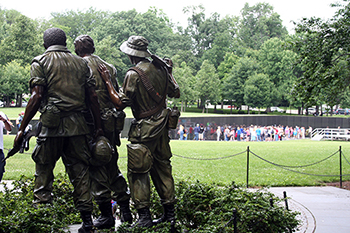
Their silent vigils eternal, their stories told in stone and steel, they guard the entries to our nation's capital and patrol the shadows of our national memory.
Their histories and meanings far from universal, they represent the common man, the citizen soldier, the warrior-poet and the girl next door - all who put themselves in harm's way.
Their sunken eyes focus far beyond the ranks of curious visitors. We are no threat; we are there to learn and to know and to ask why. Some in the crowd nod and blink and walk away; others record memories on film or reach out to touch.
The bronze warriors beckon us to stay, to listen to their stories and to share our own. For they understand.
The 'Forgotten War'
"Down the road, Marines at other fires tried to heat their food, but it was more from habit than hunger - for in that cold even hunger itself had died... They passed the last Chinese ambush where lay crumpled the men soon to be given places on others trucks and trailers farther back in the column - the men never to freeze, or worry, or go hungry ... or march again."- David Douglas Duncan, Korea, 1951
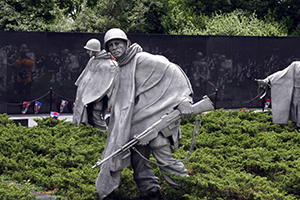
At the Korean War Veterans Memorial, 19 ghostly white soldiers patrol silently up a slope dotted with granite and juniper. Wrapped in ponchos against the cold, they trudge toward an American flag atop the ridge.
The mountainous Korean landscape looming to their right becomes, on closer inspection, a composite of hundreds of photos of veterans on a gleaming black wall.
The etched portraits represent 54,269 Americans who lost their lives in the Korean War from June 1950 to July 1953. "Freedom Is Not Free," reads an inscription on the wall. That says it all.
A Nurse In 'Nam
"What was it like to be a woman in Vietnam? We saw the worst that man could do to man, and we saw the very best of the human heart."
- Jean Youngstrom Diebolt, Women's Memorial Dedication
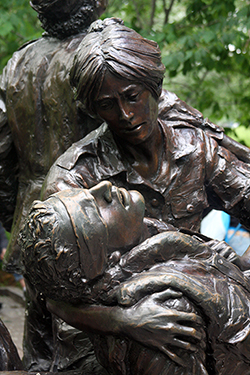
A woman in uniform looks desperately to the clouds, awaiting the arrival of a dust-off helicopter. Another cradles a wounded GI, dying in her arms. A third kneels in the background over the soldier's discarded helmet.
More than a quarter of a million women served during the 20-year span of the Vietnam War. As many as 11,000 were stationed there. Eight who died join the men on "the Wall" at the Vietnam Veterans Memorial. An unknown number of civilian women also served in Vietnam as news correspondents and as workers for the Red Cross, USO, and other organizations.
Yet, for years, until the Vietnam Women's Memorial was dedicated on Veterans Day 1993, their contributions and suffering went unnoticed and unheralded.
Today, nestled in a grove of eight trees - representing those who died - the service and dedication of women in war is recognized.
Uncommon Valor
"How could I feel like a hero when only five men in my platoon of 45 survived, when only 27 men in my company of 250 managed to escape death or injury?"
- Ira Hayes, U.S. Marine Corps
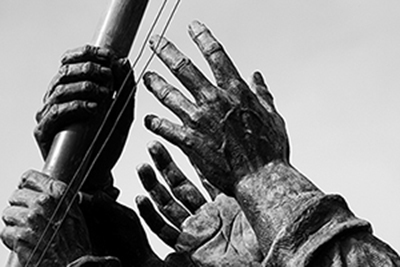
Ira Hayes, a Pima Indian from Arizona, was one of six men - five Marines and a Navy corpsman - who found themselves thrust into the uncomfortable role of national heroes by raising an American flag on Mount Suribachi.
Three would never see home again, killed on Iwo Jima in the final weeks of World War II.
The flag-raising is the inspiration for the Marine Corps War Memorial, dedicated to all Marines who gave their lives in defense of the nation since 1775.
Dedicated 46 years ago, the 32-foot-tall statue is the largest cast-bronze memorial in the world.
Of this, the bloodiest battle in Marine Corps history, Admiral Chester Nimitz said, "Among the Americans who served on Iwo Jima, uncommon valor was a common virtue."
The Lone Sailor
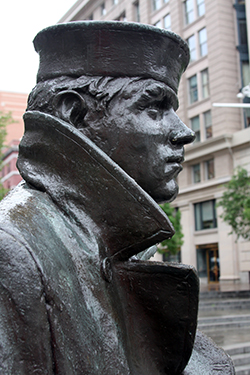
The young seaman, hands jammed in jacket pockets, sea bag at his feet, waits patiently for his ship amid the hustle of office workers and tourists.
The world's oceans at his feet, oblivious to the honks of taxis, he hears only the splash of surrounding fountains.
The Navy Memorial, a tribute to the country's enduring naval heritage, is often overlooked among the capital's memorials.
The sailor represents the millions of men and women - sailors, submariners, fliers and others - who fought their nation's wars at sea.
The Healing Goes On
"If you are able, save for them a place inside of you...
And save one backward glance when you are leaving for the places they can no longer go...
Be not ashamed to say you loved them, though you may or may not have always...
Take what they have left and what they have taught you with their dying and keep it with your own...
And in that time when men decide and feel safe to call the war insane,
Take one moment to embrace those gentle heroes you left behind..."
- Michael Davis O'Donnell, Vietnam, Jan. 1, 1970
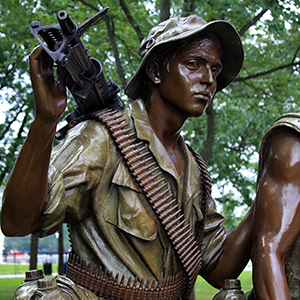
The eyes of the three servicemen hold the visitor in place as, from the safety of the treeline, they search. Devoid of politics and division, unconcerned with slogans, no longer seeking reasons, they only seek their friends - familiar names on "the Wall."
Almost four and a half million visitors annually descend into the depression cradling the Vietnam Veterans Memorial. In the 18 years since it was dedicated, the memorial has become a place of healing for those caught up in the war.
Veterans, parents, wives and now-grown children journey here to search among the 58,208 engraved names - from the first to die in 1959 to the last in 1975.
A cross beside a name indicates a serviceman is still carried as missing in action. Michael O'Donnell, a friend on row 40, panel 12, is one of those who never came home.
New In The Ranks
"I remember dropping three different times. Each time I did, machine guns burst in front of my face in the sand. I didn't stop because I knew what was coming; I dropped because I was so tired. I looked back, and I saw Walter Geldon lying out on the beach with his hand raised up asking for help. Walter never made it. He died on his third wedding anniversary."
- Sgt. Donald Scribner, 2nd Rangers, Omaha Beach, June 6, 1945
Another grander monument is about to make its appearance on the National Mall.
Saturday, more than 55 years after the end of the last great war, on the grassy slope between the Washington Monument and the Lincoln Memorial Reflecting Pool, ground was broken for the World War II Memorial.
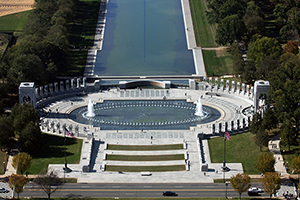
Bulldozers and jackhammers will for a time disturb the quiet around the bronze heroes of other wars, but soon the barricades will fall and the dust will settle.
The result, a peaceful place that beckons visitors to quiet contemplation, will be the first national memorial dedicated to all who served during the war - a defining period in the lives of millions.
No bronze heroes will keep vigil or portray the common soldier here. The warriors at this monument will be the men and women who share their thoughts beside the Memorial Arch, who shed tears at the Field of Gold Stars.
Maybe, as their children snap photos of the Freedom Wall and their grandchildren watch the dancing waters of the Rainbow Pool, they will tell their stories.
And, finally, we will understand.
Dave Berry is the retired editor of the Tyler Morning Telegraph. This article, from November 2000, was written as ground was being broken on the World War II Memorial. Since then, Dave has flown along as a reporter and volunteer escort on six Brookshire Grocery Co. Heroes Flights, each escorting up to 30 WWII and Korean War veterans to see their monuments in the nation's capital.
